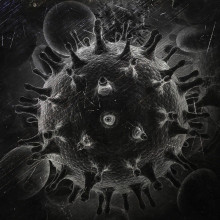Whooping cough cases surge, and looking for life on Europa
This week on The Naked Scientists: The spike in whooping cough cases occurring across Europe; what’s behind it? Also, how scientists are set to look for life on an icy moon of Jupiter. And, the new artificially intelligent gadget to make roads safer for cyclists.
In this episode

00:56 - Whooping cough cases surge in Europe
Whooping cough cases surge in Europe
Adam Finn, Bristol Medical School
Europe is facing its worst outbreak of whooping cough in a decade. Cases of the contagious infection - which is also known as pertussis - have been particularly acute in the Czech Republic, which has recorded its highest number of cases since the 1960s. The UK is also seeing an uptick in cases. But why? Adam Finn is professor of paediatrics at Bristol Medical School…
Adam - So this bugged a bacterium that lives in people's noses and mouths and throats, and it passes itself around between people by making them cough. It's quite common in the population. People who get a persistent cough that goes on for two or three months often are infected with this bug. But the reason we really, really care about it is that very young children, particularly in the first few weeks of life, get desperately ill. And indeed many of them die. So it's a very serious infection in very young children.
Chris - Do we know why it's so nasty?
Adam - It's so nasty because it makes a combination of toxic proteins that are very effective at making you cough. And it does that in order to pass itself around. But that is disastrous when it affects the respiratory tract, the lungs, and the nose and throat of a very small baby because it makes it almost impossible for them to breathe and they end up without enough oxygen. They end up with pneumonia, with infection in their lungs, which can permanently damage the lungs and they end up with brain damage and even other organs of the body can be damaged as well. So that's why it's such a nasty bug. It has this combination of factors that make these babies so desperately ill.
Chris - We do have a vaccine program, thankfully though, don't we? Is that effective?
Adam - We do indeed. And this vaccine program began a long time ago in the 1950s, at which time we used to have big epidemics of whooping cough about every three years with many hundreds of children dying and thousands of children affected. The problem seemed to have gone away. Unfortunately, what's turned out is that the vaccines that we currently use don't provide lifelong protection. So they protect the babies once they're vaccinated, but that protection doesn't last forever. And so they can get the infection later on in life when they're adolescents, when they're young adults. And that in turn means that they can infect their children and young babies who've not yet been vaccinated and still get sick.
Chris - So you succumb again to infection, but are you as desperately ill as you would've been were you not vaccinated?
Adam - We can't actually start vaccinating children till they're two months old. They need three doses of vaccines at two, three and four months. So they're not really fully protected until they're five or six months old and that means you've still got this vulnerable period very early on in life. And if the bacterium is still circulating amongst adults, then these babies are still going to get infected. So the way to solve that problem is to protect them from the time of birth. And the way we do that is by immunising the mothers with a vaccine when they're pregnant.
Chris - And how effective is this? So are adults succumbing to pertussis or whooping cough infection without realising it. So we've got the thing going through the population, but because they've been vaccinated earlier in life, they're getting a less severe infection and might not realise it.
Adam - That's right. I mean, you cough even in an unvaccinated adult is a nuisance. It makes you cough for a long time. You wouldn't like it. And you'll be feeling rotten with it for a while, but it won't kill you and you'll recover. So that's right. People perhaps don't realise they've got the whooping cough, they've got a persistent cough and they don't recognize what it is. But if they're in contact with small children, then that's when the disaster occurs. We don't at the moment have vaccines that are capable of eliminating the circulation of the bacterium altogether. We just don't have them. So the only way we can solve the problem in young children is by immunising them, and even more than that, by immunising their mothers before they're born.
Chris - We're seeing a big uptick in cases though in some countries. We've seen it go from a few tens of cases in a month to literally thousands of cases in a month. We are seeing an uptick here as well. Why do you think the numbers are suddenly climbing?
Adam - The main reason right now is that like many other infectious diseases during the covid pandemic, when everybody was not in contact with each other, whooping cough went away. So there was nobody getting whooping cough. It is a very good way of preventing infections, is just keeping people apart from each other. But of course, once we go back to normal life as we are now, then those infections come surging back and that's what's happening with whooping cough at the moment. But the other reason for it is that whooping cough has always been an illness that comes in waves. So we have a period when there are lots of cases and then more people get immune because they've had the infection or been vaccinated and it goes back down again. So we're seeing one of those waves now, but it is going to be bigger and stronger because of this absence of circulation and lack of immunity that built up during the period of the covid pandemic.
Chris - And vaccine uptake rates, have they been dented as well? Because we've seen that with, for instance, measles, which is also rearing its ugly head in our country.
Adam - Yes, unfortunately, vaccine coverage rates in this country are gradually sinking down. And I think that's due to the underinvestment in the NHS. So there's been less resources to make these programs work well, and to some degree, you know, people are losing their faith in vaccines and, and perhaps having doubts about the benefits and the importance of getting themselves and their children vaccinated. So we are seeing falling rates of vaccination and of course that makes the situation much more dangerous.
Chris - So if a person runs into the infection, they take a trip to one of these European countries where they're seeing a big surge or they know they've had contact with it. What should a person do and how do we treat it?
Adam - The only way to avoid whooping cough is to avoid being exposed to people with a cough or be vaccinated. We don't currently vaccinate adults routinely unless they're pregnant women. So the really important thing that we need to do at the moment is to make sure that pregnant women are aware of this program. Aware of the importance of it for them and their baby, and to inform all parents that they need to get their children immunised against whooping cough with the routine schedule. And if they've missed any doses, they need to get in touch with their GP and get the baby or the child immunised up to date straight away.

07:37 - Mission looking for life in Europa's water plumes
Mission looking for life in Europa's water plumes
Fabian Klenner, University of Washington
Later this year, a new chapter in the search for extraterrestrial life begins when NASA’s Europa Clipper space probe sets off for the icy moon of Jupiter that shares its name. It’ll be armed with instruments to confirm whether - as scientists suspect - there might be a vast ocean beneath the surface, and whether plumes of water periodically erupting from the surface contain biological material. Fabian Klenner, at the University of Washington, is one of the scientists testing the tools that will be on the lookout for an historic landmark in space science…
Fabian - Around two decades ago, it turned out that there are moons around Saturn and Jupiter that have liquid water. The water is not on the surface as we know it from earth, but it's on the subsurface under thick ice crusts covering these moons. Life on earth as we know it requires liquid water. We also need enough energy and interesting chemistry, chemical reactions ongoing. And all these ingredients appear to be present on these moons. In particular on Enceladus, a moon of Saturn and Europa, a moon of Jupiter.
Chris - And what keeps the water liquid given it's got that huge thick, icy crust, it's very, very cold there. It's a massive distance away from the sun. We measure the distance in millions of kilometres, don't we? Hundreds of millions of kilometres. So why is it liquid at all?
Fabian - These moons orbit their host planet, not in a perfect circular orbit. At some point they're closer to the planet and sometimes they are not so close to the planet. And these variations and gravitational forces lead to a lot of heat production in the interior of the moons. And this is enough energy to maintain liquid water.
Chris - So they get sort of stretched and squeezed as they go round. If there is life there and it's under hugely thick ice crusts, how can we find it at all?
Fabian - We can send instruments there. There will be the Europa Clipper spacecraft set for launch in October this year, and there will be one instrument on board the spacecraft that's a so-called mass spectrometer that measures ice grains that are ejected from Europa, so that are either knocked off the surface of the moon or maybe even emitted in a geyser. And if there is a mechanism, we don't know that. But if there is life at all, to bring that life into these ice grains, then we have very good chances to use such kinds of instruments to figure out if there is life or not, because the life would be entrapped.
Chris - And the thrust of this project was to ask, well what's the hallmarks of life in those ice grains if it's there?
Fabian - Yes. So we did experiments in the laboratory to simulate what these instruments in space should actually deliver to simulate this process. We used a tiny liquid water beam and injected that into a vacuum, and this liquid water beam disintegrated into droplets. And we prepared this water in a way that we added bacterial cells to our samples so that in theory, one cell is in one of these water droplets. And then we were shooting with a laser onto these water droplets to simulate the process of measuring single ice grains with these mass spectrometers in space.
Chris - What sort of range of types of cells and cell chemistries in organisations can you see? Because we're assuming, of course, that life is going to pop up in these oceans and look very similar to what life does look like on Earth, but that may not be the case at all, mightn't it? So do you think you're geared up in order to detect a range of different forms of life, regardless of what it looks like?
Fabian - So I always like to argue that there is plenty of liquid water on these moons. There is plenty of energy, there is organic chemistry, so the same ingredients are there. And I personally think it is not a bad approach to look for life as we know it on an ocean moon, like Enceladus or Europa. And so this is why we were focusing on bacterial cells that we know from Earth. And we were particularly looking at cell culture that likes cold environments that are very small, so that could fit into these ice grains. And also the same culture likes only low nutrient fluxes.
Chris - A good friend of mine, John Zarnecki, built the Huygens lander or helped to build the Huygens lander that landed on Titan, Saturn's largest moon. And I remember him saying, this will take seven years to get from launch to there. And he said, it's a long time to wait to find out whether or not you've succeeded. How long are you going to have to wait?
Fabian - <laugh>? I probably have to wait about six years, maybe six and a half. So Europe Clipper should arrive in the Jupiter system in 2030, and then hopefully return data very, very soon.
Chris - And hopefully you've got some other projects to work on in the meantime. Otherwise, you could be a very, very quiet scientist for the next six years.
Fabian - I definitely won't be very quiet. There's plenty of work to do and plenty of things to prepare for Europa Clipper and also other hopefully upcoming missions.

13:42 - CRISPR gene editing to remove HIV infection
CRISPR gene editing to remove HIV infection
Michelle Roberts, BBC
Researchers presented some preliminary data at a conference in Spain this week showing that they have successfully used the Nobel prizewinning gene editing tool “Crispr” to eliminate human immunodeficiency virus - or HIV, from infected cells in culture. HIV is problematic to cure because it inserts covert copies of its genetic code into our human DNA. It’s from these “hidden” viruses - that lurk off the immune radar - that HIV stages a comeback whenever infected patients stop taking medication. So editing them out successfully is a step closer to ridding the body of the infection, as the BBC’s digital health editor, Michelle Roberts, explains…
Michelle - They've used this technology that has been around for a few years now. It won a Nobel Prize back in 2020. And if you look at cells on the molecular level, it's like a little pair of scissors that can snip out bits of DNA, it's called gene editing. CRISPR is the actual technology we're talking about. Those little scissors can go in and start changing things within the cell and hopefully that could be really helpful because with HIV, we know that this virus gets into cells, it hijacks them and starts using the cell's own machinery to make more copies of the virus. At the moment, we've got really powerful HIV drugs that people can take that can keep it at bay, but it can't get rid of it entirely. So there's still some HIV within the body.
Chris - And the argument is if you've got a mechanism for gene editing, you could go into the cells that are harbouring that genetic message and disable the genetic message, thereby disabling the infection.
Michelle - Exactly. So you either entirely snip out a bit of the HIV genetic code, the blueprint, or you just disable it so it can't do it very well anymore. They're saying that this is very early work, so at the moment they've been looking at cells in the lab, but another company has actually started trying to do it in a few people as well. But you also need to look at safety and whether it will work well enough because we've already got really good treatments for HIV.
Chris - Indeed because about 20 years ago, if you'd come up with this, people would've said, let's give it a go. I've got nothing to lose. But now we have a situation where a person with HIV adequately treated has got the same life expectancy as someone without HIV. So you're sort of saying to someone who's healthy that they have a potentially risky procedure, which might not be attractive to them.
Michelle - Yeah, it's still unchartered waters. I mean, people have been using this CRISPR, these little molecular scissors if you like, for other things too, because you can see how, if you can tinker with, with DNA and correct some things that are going wrong, you could treat lots of different things. They have been using it for some types of site loss, genetic site loss. They've looked at it for sickle cell disease, various things. And there are some early promising findings. But then also researchers are really monitoring what are the side effects because you might get some slight off target editing and that could cause other issues that might not be apparent at the moment.
Chris - What do we think the risk of that happening is? If it's good enough to go into people already? Presumably scientists think they've got a pretty good handle on how good and how accurate this set of molecular scissors can be made to be. So how risky is it?
Michelle - It's really difficult at the moment to put a number or if you had a patient in front of you, it would be really hard to say, well, one in 10 people have no side effects or, you know, some sort of tangible risk. The other difficulty with this type of technology is we're talking about such minute levels that you've got to get this way of editing into the cell and they found that this CRISPR technology, the packaging you need to get it into the cell is quite bulky. So these researchers at the moment who've been looking at HIV, have been trying to find different methods of getting that size of the package down small and small and smaller to get it into the cell efficiently.
Chris - And what about other viruses beyond just HIV? Because I think I read a few years ago, people were saying when you catch one of the herpes viruses like chicken pox and get shingles because it keeps coming back or herpes simplex that causes cold sores because it keeps coming back from your nervous system. If we could do this sort of gene editing, you could disable that virus wherever it's resident in the body and then you wouldn't suffer painful blisters periodically.
Michelle - I mean that would make sense, there are lots of different infections that can lay dormant for a while but can then reemerge and cause problems. It would make sense if you can find the right genetic code, you can deliver this package that can get into the cell and start changing that DNA or disabling some of it without causing any side effects. That's the massive question mark here. You know, we need to be sure that these treatments are safe enough because even with chicken pox and other things that can reactivate, we do have other treatments out there.
Chris - And when you spoke to the team, were they confident they're going to be able to crack this nut or are they saying, look, this is promising but it's so far off into the future, don't hold your breath.
Michelle - They're very excited, but it's certainly not going to be tomorrow. And they were quite open about that. They were saying, you know, we really don't want to suggest that we've got a cure round the corner. It's not that, but it is exciting science and given that lots of people are exploring different diseases with this CRISPR technology, it's definitely one to keep watching and pushing on.

19:34 - The AI 'Co-Pilot' bike light that makes cycling safer
The AI 'Co-Pilot' bike light that makes cycling safer
Clarke Haynes, Velo AI
Over 10,000 cyclists are injured, and more than a hundred are killed, each year on Britain’s roads. Often it’s because approaching vehicles don’t see them, and the cyclists only find out too late that they need to take evasive action. So can AI help? A device called Copilot - which is an AI-powered bike light that uses smart sensors to constantly watch the roads and the movement of vehicles - forewarns road users and cyclists of potentially dangerous situations with audio cues. The founder and CEO of velo.ai, Clark Haynes, explains how it works…
Clark - It's bringing a lot of the advanced tech that you find in things like the modern automobile and really bringing it to bear for safety. For the cyclist right now, it's about the size, a little bit larger than a deck of cards. It's small enough that it tucks just right under your seat. It's rearward looking, so it's watching out for vehicles behind you and it's battery powered, so it'll last for about five hours off of its internal battery. So you can just go for a ride and you're all set.
Chris - That's still pretty small to have the power of an artificial intelligence system scanning a road for you. What's it doing? Is it using cameras then to watch what's coming up behind?
Clark - Exactly. There are existing competitive products out there that use radar sensors and we just looked for cameras as a better way of understanding the world and you can do so much more with a better sensor. So the device itself is primarily composed of a camera that's watching the world, a set of lights that can react to things in the world, like other drivers, audio that can be used to cue the bicyclist and then onboard compute - a Raspberry Pi, made right in the UK paired with a special AI chip. And that's what really allows us to do all of this computer vision image processing in real time on a really, really low power budget so that we can run off of batteries.
Chris - What does the AI do with the camera pictures and then what's the output from the device to warn the cyclist?
Clark - It's watching the world, it's understanding the world from the perspective of the bicyclist and it's able to essentially detect approaching vehicles and understand what they're doing and what their behaviour is. I've actually been spending my career strapping cameras to robots and autonomous vehicles, so a lot of the opportunity here was to bring some of that intelligence to the world of cycling.
Chris - So if you're in danger of being rear-ended or what they dub in the industry, a Smid Sea, sorry mate, I didn't see you. Then. This should be able to anticipate those sorts of things that, that claim the lives of or cause injuries to cyclists and then warn them.
Clark - Exactly. That's our goal and it's a warning to the cyclist, but then it's also a warning to the driver. The design is that a few seconds before that you're going after something more like a startle reflex because we can have reactive light patterns that change and try to get the attention of a potentially distracted driver.
Chris - Have you road tested it till, you know, if it does give people enough warning to make a reasonable difference that will avoid an accident or improve the safety for cyclists?
Clark - Yeah, absolutely. We've been road testing for almost a year and a half with earlier beta versions and now with our production version out with the public, and right now these are all over the US but also a natural focus in our home city of Pittsburgh, Pennsylvania, which is a challenging city with lots of difficult roads full of potholes, hills, weather, you know, bad drivers too. All of those things. The feedback we get from our users is that, yes, drivers are giving me more space and I feel safer and more confident biking on these roads because I know what's going on behind me and that's really the goal of what we're doing. We actually just built a rig that's going to allow us to really accurately measure some of these outcomes and we intend to publish the results of that in the coming months.
Chris - How do you see the approach and the technology going forward, could this be deployed in different ways, different vehicles, different contexts, or are you going to develop this just for the cycle market more, and if so, what will you add?
Clark - Yeah, that's a great question. The biggest thing for us with cycling is that you have such a passionate set of users and a community that's focused on safety because you know, every cyclist is riding on the roads and they're wishing, Hey, I just want to come home safe. And so I think it's a great place to start. That being said, you know, we find all sorts of mobility are taking hold in our cities, particularly this kind of personal micro mobility, so this is bikes, but this is also scooters and one wheels and all of these new contraptions. We see this really coming to bear across all forms of personal micro mobility.

How did the Romans multiply their numerals?
Ems - Thinking about how we multiply today can be helpful answering this question too - there's many methods and they often vary by region so there may be no definitive answer BUT it seems likely that they used a method of doubling and halving which is very straightforward and there is evidence it was used in Egyptian times from the Rhind papyrus (probably worth discussing this method eg 37x39 (ignore odds as remainders) so doubling and having gives 18x78, doing again gives 9x156 and then 4x312 and 2x624 and finally 1x1248 and to get the final answer we 'cast out' any of those with both numbers even (eg 18x78) and total the RHS of the rest which gives 1443 - it might seem complex to us but it is a binary approach really and only appears tricky because we do not always use this approach - familiarity arguably bring fluency and speed - this doubling and halving is used elsewhere eg also known as Russian method or Russian peasants method.
Will - It seemed to work well for them, didn't it?
Ems - Romans are believed to have tended to often write III for 4 than IV - evidence on their remaining inscriptions- so doubling and halving was perhaps easier than we thought. But as always, getting the answer is key rather than the method and clearly Romans could perform great feats of engineering so their methods worked.










Comments
Add a comment